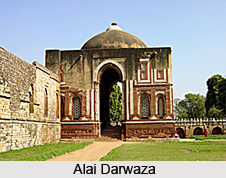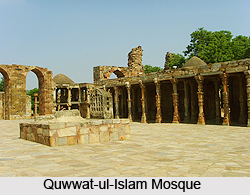 Imperial style of architecture developed and gained prominence during the period of Delhi Sultanate. Qutub- ud- din Aibak constructed few monuments which have the imprint of both Hindu and Muslim art. Even during the reign of Iltutmish and Ala- ud- din Khilji, there were several specimens of architecture which were built. The Tughlaqs also played an imperative role in the thriving of the imperial style of architecture.
Imperial style of architecture developed and gained prominence during the period of Delhi Sultanate. Qutub- ud- din Aibak constructed few monuments which have the imprint of both Hindu and Muslim art. Even during the reign of Iltutmish and Ala- ud- din Khilji, there were several specimens of architecture which were built. The Tughlaqs also played an imperative role in the thriving of the imperial style of architecture.
Qutub-ud-din Aibak constructed the Quwat- ul- Islam mosque at Delhi and another mosque at Ajmer called the Dhai Din Ka Jhonpra. The first was raised at the site of a destroyed temple and the other at the location of a ruined college of Sanskrit. Therefore, both these mosques have the impression of both Hindu and Muslim art. Sultan Iltutmish and Ala-ud-din Khilji added to the Quwat-ul-Islam mosque. The construction of the Qutub Minar though started by Aibak but it was completed by Iltutmish. The planning of this monument was purely Islamic and was originally intended to serve as a place for the muazzin but afterwards, it became famous as a tower of victory. Qutub Minar is an impressive building and according to many historians it is one of the most perfect examples of a tower known to exist anywhere in the world.
 Iltutmish constructed a tomb on the grave of his eldest son which is known as Sultan- Ghari. He also built Hauz-i-Shamsi, Shamsi-Idgah, Jami Masjid at Badaun and the Atarkin-ka-Darwaza at Nagaur (Jodhpur). He made additions to Quwat-ul-Islam and Dhai Din Ka Jhonpra. Balban built his own tomb and the red palace at Delhi. His construction marked a notable landmark in the development of Indo-Islamic architecture. A number of magnificent buildings were constructed under the reign of Ala- ud- din Khilji. He had good economic resources and his buildings were constructed with perfectly Islamic viewpoint and have been regarded as few best examples of Islamic art in India. Ala- ud- din founded the city of Siri, built a palace of thousands of pillars within it, Jamait Khan Mosque at the shrine of Nizam- ud- din Auliya and the famous Alai Darwaza at the Qutub Minar. The Alai Darwaza is considered as one of the most treasured possession of Islamic architecture. Ala- ud- din known constructed a magnificent tank covering an area of nearly seventy acres, known as Hauz-i-Alai or Hauz-i-Khas near his newly constructed city of Siri in the vicinity of the old city of Delhi.
Iltutmish constructed a tomb on the grave of his eldest son which is known as Sultan- Ghari. He also built Hauz-i-Shamsi, Shamsi-Idgah, Jami Masjid at Badaun and the Atarkin-ka-Darwaza at Nagaur (Jodhpur). He made additions to Quwat-ul-Islam and Dhai Din Ka Jhonpra. Balban built his own tomb and the red palace at Delhi. His construction marked a notable landmark in the development of Indo-Islamic architecture. A number of magnificent buildings were constructed under the reign of Ala- ud- din Khilji. He had good economic resources and his buildings were constructed with perfectly Islamic viewpoint and have been regarded as few best examples of Islamic art in India. Ala- ud- din founded the city of Siri, built a palace of thousands of pillars within it, Jamait Khan Mosque at the shrine of Nizam- ud- din Auliya and the famous Alai Darwaza at the Qutub Minar. The Alai Darwaza is considered as one of the most treasured possession of Islamic architecture. Ala- ud- din known constructed a magnificent tank covering an area of nearly seventy acres, known as Hauz-i-Alai or Hauz-i-Khas near his newly constructed city of Siri in the vicinity of the old city of Delhi.
The Tughlaqs were puritanical in taste and thus their buildings were devoid of any ornamentation. Ghiyas-ud-din constructed the new city of Tughlaqabad in the east of the Qutub area, his own tomb and a palace which was constructed in golden bricks. Muhammad Bin Tughlaq constructed the new city of Jahanpanah near the city of old Delhi, the fort of Adilabad and few other buildings at Daultabad. But all his buildings have been destroyed. The only two buildings which remain are the Sathpalahbund and the Bijai- Mandal. Among the distinguished buildings constructed by Firoz Tughlaq are the new city of Firuzabad near the old city of Delhi, the palace fort known as Kotla Firuz Shah within it. During his reign, a noble at the court, Khan-i-Jahan Jauna Shah constructed the tomb of his father, Tilangani, the Kali Masjid and the Khirki Masjid in the city of Jahanpanah. A striking building known as Lal-Gumbad, was constructed by Nasir-ud-din Muhammad Tughlaq Shah at the grave of Kabir-ud-din Auliya. Among the buildings constructed by Lodi and Sayyid Sultans, are the tombs of Mubarak Shah Sayyid, Muhammad Shah Sayyid and Sikandar Lodi.
Most of the buildings raised by Sultans of the Delhi Sultanate which includes palaces and forts have been destroyed. Only a few tombs, mosques and minars have existed so far. The buildings which are good specimens of early imperial style of architecture in India and the best among them are the Qutub Minar and the Alai-Darwaza.



















